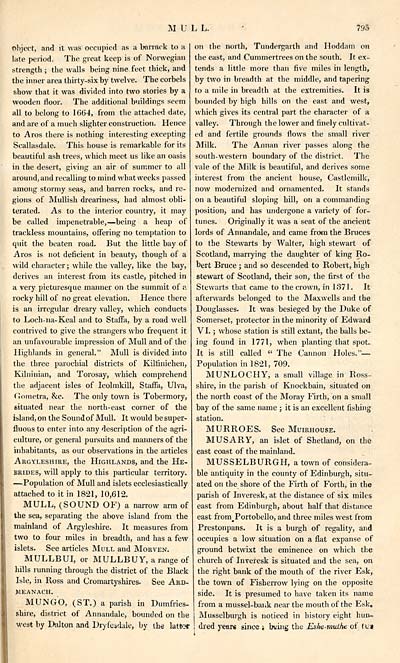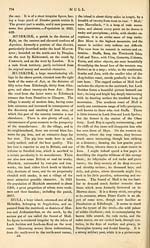Gazetteer of Scotland > Volume 2
(311) Page 795 - MUL
Download files
Complete book:
Individual page:
Thumbnail gallery: Grid view | List view

M U L L.
795
object, and it was occupied as a barrack to a
late period. The great keep is of Norwegian
strength ; the walls being nine feet thick, and
the inner area thirty-six by twelve. The corbels
show that it was divided into two stories by a
wooden floor. The additional buildings seem
all to belong to 1 664, from the attached date,
and are of a much slighter construction. Hence
to Aros there is nothing interesting excepting
Scallasdale. This bouse is remarkable for its
beautiful ash trees, which meet us like an oasis
in the desert, giving an air of summer to all
around, and recalling to mind what weeks passed
among stormy seas, and barren rocks, and re-
gions of Mullish dreariness, had almost obli-
terated. As to the interior country, it may
be called impenetrable, — being a heap of
trackless mountains, offering no temptation to
quit the beaten road. But the little bay of
Aros is not deficient in beauty, though of a
wild character; while the valley, like the bay,
derives an interest from its castle, pitched in
a very picturesque manner on the summit of a
rocky hill of no great elevation. Hence there
is an irregular dreary valley, which conducts
to Loch-na-Keal and to Staffa, by a road well
contrived to give the strangers who frequent it
an unfavourable impression of Mull and of the
Highlands in general." Mull is divided into
the three parochial districts of Kilfinichen,
Kilninian, and Torosay, which comprehend
the adjacent isles of Icolmkill, Staffa, Ulva,
(iometra, &c. The only town is Tobermory,
situated near the north-east corner of the
island, on the Sound of Mull. It would be super-
fluous to enter into any description of the agri-
culture, or general pursuits and mariners of the
inhabitants, as our observations in the articles
Argyleshire, the Highlands, and the He-
brides, will apply to this particular territory.
— Population of Mull and islets ecclesiastically
attached to it in 1821, 10,612.
MULL, (SOUND OF) a narrow arm of
the sea, separating the above island from the
mainland of Argyleshire. It measures from
two to four miles in breadth, and has a few
islets. See articles Mull and Morven.
MULLBUI, or MULLBUY, a range of
hills running through the district of the Black
Isle, in Ross and Cromartyshires. See Ard-
MEANACH.
MUNGO, (ST.) a parish in Dumfries-
shire, district of Annandale, bounded on the
west by Dal ton and Dryfesdale, by the latter
on the north, Tundergarth and Hoddam on
the east, and Cummertrees on the south. It ex-
tends a little more than five miles in length,
by two in breadth at the middle, and tapering
to a mile in breadth at the extremities. It is
bounded by high hills on the east and west,
which gives its central part the character of a
valley. Through the lower and finely cultivat-
ed and fertile grounds flows the small river
Milk. The Annan river passes along the
south-western boundary of the district. The
vale of the Milk is beautiful, and derives some
interest from the ancient house, Castlemilk,
now modernized and ornamented. It stands
on a beautiful sloping hill, on a commanding
position, and has undergone a variety of for-
tunes. Originally it was a seat of the ancient
lords of Annandale, and came from the Bruces
to the Stewarts by Walter, high stewart of
Scotland, marrying the daughter of king Ro-
bert Bruce ; and so descended to Robert, high
stewart of Scotland, their son, the first of the
Stewarts that came to the crown, in 1371. It
afterwards belonged to the Maxwells and the
Douglasses. It was besieged by the Duke of
Somerset, protector in the minority of Edward
VI. ; whose station is still extant, the balls be-
ing found in 1771, when planting that spot.
It is still called " The Cannon Holes." —
Population in 1821, 709.
MUNLOCHY, a small village in Ross-
shire, in the parish of Knockbain, situated on
the north coast of the Moray Firth, on a small
bay of the same name ; it is an excellent fishing
station.
MURROES. See Muirhouse.
MUSARY, an islet of Shetland, on the
east coast of the mainland.
MUSSELBURGH, a town of considera-
ble antiquity in the county of Edinburgh, situ-
ated on the shore of the Firth of Forth, in the
parish of Inveresk, at the distance of six miles
east from Edinburgh, about half that distance
east from_Portobello, and three miles west from
Prestonpans. It is a burgh of regality, and
occupies a low situation on a flat expanse of
ground betwixt the eminence on which the
church of Inveresk is situated and the sea, on
the right bank of the mouth of the river Esk,
the town of Fisherrow lying on the opposite
side. It is presumed to have taken its name
from a mussel-bank near the mouth of the Esk.
Musselburgh is noticed in history eight hun-
dred year* since ; being the Eske-muthe of (l ; »
795
object, and it was occupied as a barrack to a
late period. The great keep is of Norwegian
strength ; the walls being nine feet thick, and
the inner area thirty-six by twelve. The corbels
show that it was divided into two stories by a
wooden floor. The additional buildings seem
all to belong to 1 664, from the attached date,
and are of a much slighter construction. Hence
to Aros there is nothing interesting excepting
Scallasdale. This bouse is remarkable for its
beautiful ash trees, which meet us like an oasis
in the desert, giving an air of summer to all
around, and recalling to mind what weeks passed
among stormy seas, and barren rocks, and re-
gions of Mullish dreariness, had almost obli-
terated. As to the interior country, it may
be called impenetrable, — being a heap of
trackless mountains, offering no temptation to
quit the beaten road. But the little bay of
Aros is not deficient in beauty, though of a
wild character; while the valley, like the bay,
derives an interest from its castle, pitched in
a very picturesque manner on the summit of a
rocky hill of no great elevation. Hence there
is an irregular dreary valley, which conducts
to Loch-na-Keal and to Staffa, by a road well
contrived to give the strangers who frequent it
an unfavourable impression of Mull and of the
Highlands in general." Mull is divided into
the three parochial districts of Kilfinichen,
Kilninian, and Torosay, which comprehend
the adjacent isles of Icolmkill, Staffa, Ulva,
(iometra, &c. The only town is Tobermory,
situated near the north-east corner of the
island, on the Sound of Mull. It would be super-
fluous to enter into any description of the agri-
culture, or general pursuits and mariners of the
inhabitants, as our observations in the articles
Argyleshire, the Highlands, and the He-
brides, will apply to this particular territory.
— Population of Mull and islets ecclesiastically
attached to it in 1821, 10,612.
MULL, (SOUND OF) a narrow arm of
the sea, separating the above island from the
mainland of Argyleshire. It measures from
two to four miles in breadth, and has a few
islets. See articles Mull and Morven.
MULLBUI, or MULLBUY, a range of
hills running through the district of the Black
Isle, in Ross and Cromartyshires. See Ard-
MEANACH.
MUNGO, (ST.) a parish in Dumfries-
shire, district of Annandale, bounded on the
west by Dal ton and Dryfesdale, by the latter
on the north, Tundergarth and Hoddam on
the east, and Cummertrees on the south. It ex-
tends a little more than five miles in length,
by two in breadth at the middle, and tapering
to a mile in breadth at the extremities. It is
bounded by high hills on the east and west,
which gives its central part the character of a
valley. Through the lower and finely cultivat-
ed and fertile grounds flows the small river
Milk. The Annan river passes along the
south-western boundary of the district. The
vale of the Milk is beautiful, and derives some
interest from the ancient house, Castlemilk,
now modernized and ornamented. It stands
on a beautiful sloping hill, on a commanding
position, and has undergone a variety of for-
tunes. Originally it was a seat of the ancient
lords of Annandale, and came from the Bruces
to the Stewarts by Walter, high stewart of
Scotland, marrying the daughter of king Ro-
bert Bruce ; and so descended to Robert, high
stewart of Scotland, their son, the first of the
Stewarts that came to the crown, in 1371. It
afterwards belonged to the Maxwells and the
Douglasses. It was besieged by the Duke of
Somerset, protector in the minority of Edward
VI. ; whose station is still extant, the balls be-
ing found in 1771, when planting that spot.
It is still called " The Cannon Holes." —
Population in 1821, 709.
MUNLOCHY, a small village in Ross-
shire, in the parish of Knockbain, situated on
the north coast of the Moray Firth, on a small
bay of the same name ; it is an excellent fishing
station.
MURROES. See Muirhouse.
MUSARY, an islet of Shetland, on the
east coast of the mainland.
MUSSELBURGH, a town of considera-
ble antiquity in the county of Edinburgh, situ-
ated on the shore of the Firth of Forth, in the
parish of Inveresk, at the distance of six miles
east from Edinburgh, about half that distance
east from_Portobello, and three miles west from
Prestonpans. It is a burgh of regality, and
occupies a low situation on a flat expanse of
ground betwixt the eminence on which the
church of Inveresk is situated and the sea, on
the right bank of the mouth of the river Esk,
the town of Fisherrow lying on the opposite
side. It is presumed to have taken its name
from a mussel-bank near the mouth of the Esk.
Musselburgh is noticed in history eight hun-
dred year* since ; being the Eske-muthe of (l ; »
Set display mode to: Large image | Transcription
Images and transcriptions on this page, including medium image downloads, may be used under the Creative Commons Attribution 4.0 International Licence unless otherwise stated. ![]()
| Gazetteers of Scotland, 1803-1901 > Gazetteer of Scotland > Volume 2 > (311) Page 795 - MUL |
|---|
| Permanent URL | https://digital.nls.uk/97434554 |
|---|
| Description | Volume II: Glenbanchor to Zetland. |
|---|---|
| Attribution and copyright: |
|
| Description | By Robert Chambers and William Chambers. Glasgow: Blackie & Son, 1838. 2 volumes. |
|---|---|
| Shelfmark | NF.1461.g.7 |
| Additional NLS resources: | |

